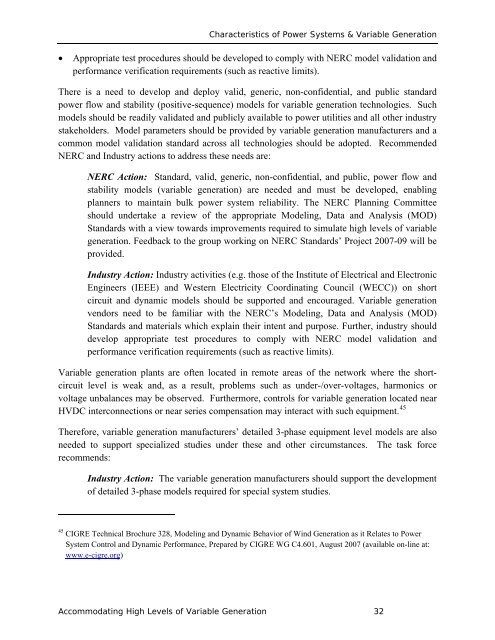Accommodating High Levels of Variable Generation - NERC
Accommodating High Levels of Variable Generation - NERC
Accommodating High Levels of Variable Generation - NERC
Create successful ePaper yourself
Turn your PDF publications into a flip-book with our unique Google optimized e-Paper software.
Characteristics <strong>of</strong> Power Systems & <strong>Variable</strong> <strong>Generation</strong><br />
• Appropriate test procedures should be developed to comply with <strong>NERC</strong> model validation and<br />
performance verification requirements (such as reactive limits).<br />
There is a need to develop and deploy valid, generic, non-confidential, and public standard<br />
power flow and stability (positive-sequence) models for variable generation technologies. Such<br />
models should be readily validated and publicly available to power utilities and all other industry<br />
stakeholders. Model parameters should be provided by variable generation manufacturers and a<br />
common model validation standard across all technologies should be adopted. Recommended<br />
<strong>NERC</strong> and Industry actions to address these needs are:<br />
<strong>NERC</strong> Action: Standard, valid, generic, non-confidential, and public, power flow and<br />
stability models (variable generation) are needed and must be developed, enabling<br />
planners to maintain bulk power system reliability. The <strong>NERC</strong> Planning Committee<br />
should undertake a review <strong>of</strong> the appropriate Modeling, Data and Analysis (MOD)<br />
Standards with a view towards improvements required to simulate high levels <strong>of</strong> variable<br />
generation. Feedback to the group working on <strong>NERC</strong> Standards’ Project 2007-09 will be<br />
provided.<br />
Industry Action: Industry activities (e.g. those <strong>of</strong> the Institute <strong>of</strong> Electrical and Electronic<br />
Engineers (IEEE) and Western Electricity Coordinating Council (WECC)) on short<br />
circuit and dynamic models should be supported and encouraged. <strong>Variable</strong> generation<br />
vendors need to be familiar with the <strong>NERC</strong>’s Modeling, Data and Analysis (MOD)<br />
Standards and materials which explain their intent and purpose. Further, industry should<br />
develop appropriate test procedures to comply with <strong>NERC</strong> model validation and<br />
performance verification requirements (such as reactive limits).<br />
<strong>Variable</strong> generation plants are <strong>of</strong>ten located in remote areas <strong>of</strong> the network where the shortcircuit<br />
level is weak and, as a result, problems such as under-/over-voltages, harmonics or<br />
voltage unbalances may be observed. Furthermore, controls for variable generation located near<br />
HVDC interconnections or near series compensation may interact with such equipment. 45<br />
Therefore, variable generation manufacturers’ detailed 3-phase equipment level models are also<br />
needed to support specialized studies under these and other circumstances. The task force<br />
recommends:<br />
Industry Action: The variable generation manufacturers should support the development<br />
<strong>of</strong> detailed 3-phase models required for special system studies.<br />
45 CIGRE Technical Brochure 328, Modeling and Dynamic Behavior <strong>of</strong> Wind <strong>Generation</strong> as it Relates to Power<br />
System Control and Dynamic Performance, Prepared by CIGRE WG C4.601, August 2007 (available on-line at:<br />
www.e-cigre.org)<br />
<strong>Accommodating</strong> <strong>High</strong> <strong>Levels</strong> <strong>of</strong> <strong>Variable</strong> <strong>Generation</strong> 32
















